



Table of Contents
- Introduction to Varnish Paints
- Types of Varnish Paints
- Benefits of Varnish Paints
- Application Process of Varnish Paints
- Choosing the Right Varnish Paint for Your Home
- Tips for Maintaining Varnished Surfaces
- Environmental and Safety Considerations
- Conclusion
- Faq's
Introduction to Varnish Paints
Varnish is a clear, hard, protective finish that is commonly applied to wood but can also be used on various other materials. Unlike traditional paint, varnish contains little to no pigment, allowing it to preserve and enhance the natural appearance of the surface it covers. This finish is primarily composed of resin, solvent, and oil, which work together to create a durable and glossy layer that protects the underlying material.
The primary purpose of varnish is to safeguard wood from damage while highlighting its natural grain. This makes it a popular choice for furniture, flooring, and other wooden surfaces where the aesthetic appeal of the wood is essential. By creating a protective barrier, varnish helps prevent moisture, dirt, and other environmental elements from penetrating and damaging the wood.
In India, varnish paints are widely favored due to their ability to combine functionality with beauty. They not only protect wooden surfaces from harsh weather conditions but also enhance their natural beauty, making them a preferred choice for both indoor and outdoor applications. Whether it's for maintaining the elegance of antique furniture or protecting modern wooden structures, varnish remains a crucial component in Indian homes.
Also Read: MDF vs Plywood: A Comprehensive Comparison
Types of Varnish Paints
Oil-Based Varnish
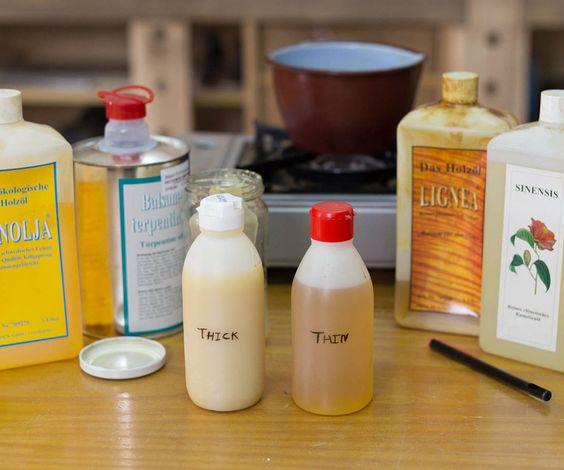 Oil Based Varnish, Pinterest
Oil Based Varnish, Pinterest
Description:
Oil-based varnishes are crafted from drying oils, such as linseed oil or tung oil, combined with resins. These varnishes are among the most traditional and widely used in woodworking and other applications. When applied, they penetrate the wood, enhancing its natural grain and providing a warm, rich finish that deepens the wood's color. The high resin content in oil-based varnishes contributes to a tough, durable coating that can withstand wear and tear.
- Advantages:
One of the key benefits of oil-based varnish is its durability. It forms a hard, resilient surface that is highly resistant to water, making it an excellent choice for both indoor and outdoor wooden surfaces. Its robustness ensures that it can endure heavy usage and exposure to elements without degrading quickly. Additionally, oil-based varnishes are versatile, suitable for a wide range of wood types, and can be used in high-humidity areas like kitchens and bathrooms.
- Disadvantages:
However, oil-based varnishes have a few drawbacks. They have a longer drying time compared to other varnish types, often requiring 24 to 48 hours between coats. This extended drying period can prolong the overall project timeline. Furthermore, they emit strong odors during application due to the high levels of volatile organic compounds (VOCs) present, necessitating adequate ventilation during use. The yellowing effect over time is another concern, particularly for lighter woods or finishes where color clarity is desired.
Water-Based Varnish
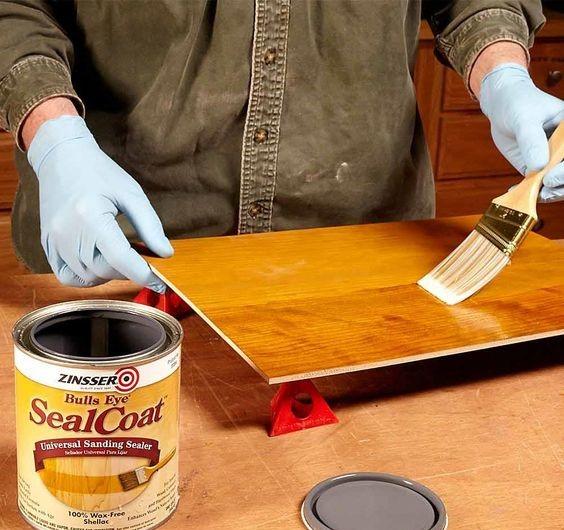 Water Based Varnish, Pinterest
Water Based Varnish, Pinterest
Description:
Water-based varnishes are formulated using acrylic or urethane resins dispersed in water, making them an environmentally friendly alternative to traditional oil-based varnishes. These varnishes are gaining popularity in India, especially in homes and businesses looking for safer, low-VOC products. When applied, water-based varnish dries clear, preserving the natural color of the wood without imparting any yellowish tint.
- Advantages:
Water-based varnishes offer several advantages over their oil-based counterparts. They dry much faster, often within a few hours, allowing for multiple coats to be applied in a single day. The low odor during application makes them more comfortable to work with, especially in enclosed spaces. Cleanup is also easier, as tools and brushes can be rinsed clean with water, reducing the need for harsh solvents.
- Disadvantages:
On the downside, water-based varnishes are generally less durable than oil-based ones. They may not offer the same level of protection against wear, especially in high-traffic areas. Additionally, the application of water-based varnish can raise the wood grain, requiring additional sanding between coats to achieve a smooth finish. While they are water-resistant, they are not as effective in outdoor settings or areas exposed to high levels of moisture.
Polyurethane Varnish
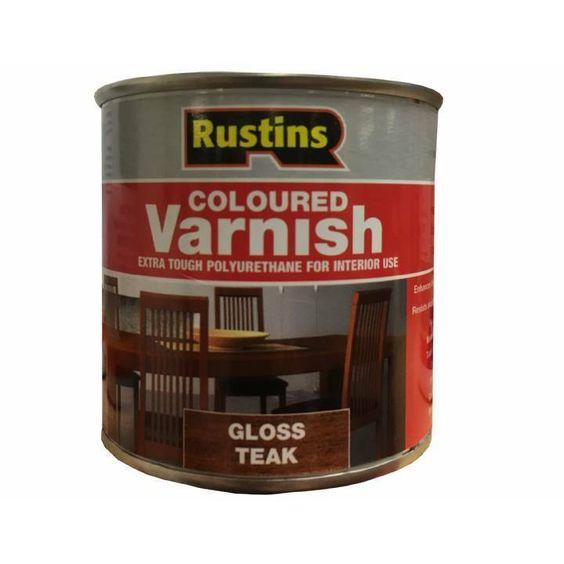 Polyurethane Varnish, Pinterest
Polyurethane Varnish, Pinterest
Description:
Polyurethane varnish is a synthetic varnish known for its superior durability and resistance to various forms of damage, including scratches, heat, and chemicals. It is available in both oil-based and water-based formulations, with the oil-based version providing a more robust finish and the water-based version offering a clearer coat. Polyurethane is particularly favored in settings where the varnish needs to withstand heavy use.
- Advantages:
Polyurethane varnish excels in durability, making it an ideal choice for surfaces that experience heavy foot traffic, such as floors, or are subject to frequent use, like tabletops. Its resistance to heat makes it suitable for kitchen countertops and other areas where hot objects may be placed. Moreover, polyurethane varnish is versatile, suitable for both indoor and outdoor applications, ensuring long-lasting protection against the elements.
- Disadvantages:
Despite its many strengths, polyurethane varnish has some drawbacks. Over time, it can yellow, particularly the oil-based versions, which might not be desirable for light-colored woods or surfaces where maintaining the original color is important. Additionally, polyurethane varnish is often more expensive than other varnish types, which could be a consideration for large projects or those on a budget. Its strong odor during application, especially with the oil-based version, also necessitates good ventilation.
Spar Varnish
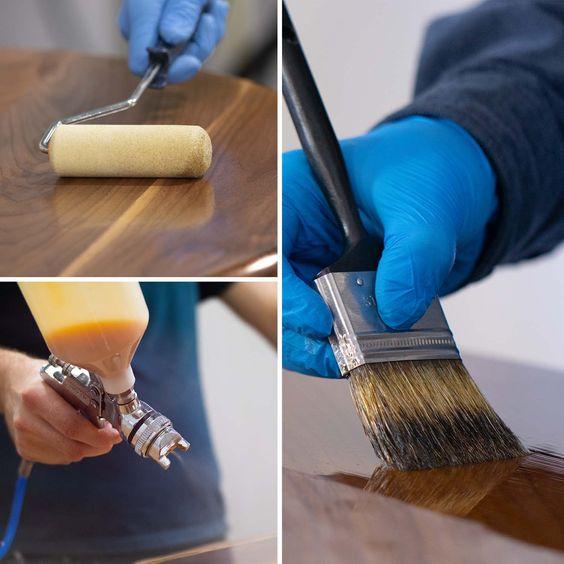 Spar Varnish, Pinterest
Spar Varnish, Pinterest
Description:
Spar varnish, originally designed for marine environments, is highly valued for its flexibility and resilience against harsh weather conditions. This varnish contains a higher oil content than other varnishes, which allows it to expand and contract with the wood in response to temperature and humidity changes. Spar varnish is ideal for protecting surfaces that are exposed to water, UV rays, and salt, making it a preferred choice for outdoor furniture, boats, and other marine applications.
- Advantages:
The primary advantage of spar varnish is its exceptional resistance to water and UV rays, making it suitable for outdoor use where other varnishes might fail. Its flexibility prevents it from cracking or peeling under extreme conditions, ensuring that the wooden surfaces remain protected for a longer time. Additionally, spar varnish can provide a glossy finish that enhances the appearance of outdoor woodwork, making it not just protective but also aesthetically pleasing.
- Disadvantages:
The high level of protection that spar varnish offers comes at a cost. It is more expensive than other varnishes and may require multiple coats to achieve the desired level of protection, especially on surfaces that are frequently exposed to the elements. The application process can also be time-consuming, and due to its high oil content, spar varnish has a longer drying time. These factors may make it less convenient for quick projects or those with budget constraints.
Acrylic Varnish
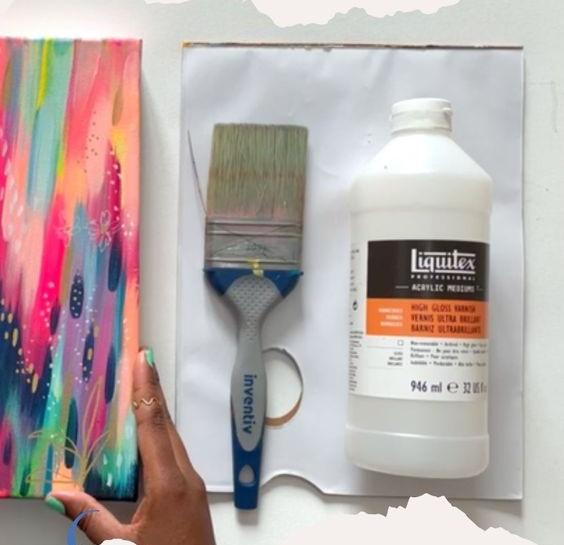 Acrylic Varnish, Pinterest
Acrylic Varnish, Pinterest
Description:
Acrylic varnish is a water-based varnish that provides a clear, non-yellowing finish. It is often used when maintaining the true color of the wood is important. Acrylic varnishes are known for being non-toxic, making them a safer option for indoor use, especially in homes with children or pets. They also offer good resistance to UV rays, preventing the wood from fading over time.
- Advantages:
One of the key benefits of acrylic varnish is its quick drying time, allowing for faster project completion. It is non-toxic, which makes it a preferred choice for indoor applications, particularly in environments where safety is a concern. Acrylic varnish also offers excellent UV resistance, which helps in preserving the wood's natural color and prevents it from yellowing or fading over time. Its water-based formulation allows for easy cleanup with just soap and water, adding to its convenience.
- Disadvantages:
While acrylic varnish is great for indoor use, it is not as durable as other varnishes like polyurethane or spar varnish, especially in high-traffic areas or outdoor settings. It may require more frequent reapplication to maintain its protective qualities. Additionally, acrylic varnish may not provide the same level of sheen or depth as oil-based varnishes, which could be a drawback for those looking for a richer finish. It is also generally less effective in protecting against water damage compared to spar or polyurethane varnishes.
Also Read: Ganpati Decoration Ideas For Your Home: Ganesh Chaturthi 2024
Benefits of Varnish Paints
 Benefits of Varnish Paints
Benefits of Varnish Paints
Enhances Natural Beauty
Varnish paints are highly valued for their ability to accentuate the natural grain and texture of wood. Unlike opaque paints that cover the wood's surface, varnish allows the inherent characteristics of the wood to shine through. When applied, varnish deepens the color and adds a subtle sheen that enhances the wood's rich, warm tones. This not only makes the wood more aesthetically pleasing but also adds a level of sophistication and elegance to furniture, flooring, and other wooden elements. For homeowners and craftsmen who appreciate the natural beauty of wood, varnish is an ideal choice as it preserves and amplifies the wood's unique features.
Protects Wood
One of the primary functions of varnish is to protect wooden surfaces from various environmental threats. Wood is naturally porous, making it susceptible to moisture, which can lead to swelling, warping, and rot. Varnish creates a waterproof barrier that prevents moisture from penetrating the wood, thus extending its lifespan. Additionally, varnish protects wood from the harmful effects of sunlight, such as fading and discoloration caused by UV rays. The protective layer formed by varnish also guards against scratches, stains, and wear, keeping the wood in good condition even with regular use. This protective quality makes varnish an essential finish for preserving the integrity and appearance of wood in both indoor and outdoor environments.
Durability
Varnish is renowned for its durability, making it a reliable choice for surfaces that need to withstand daily wear and tear. Once fully cured, varnish forms a hard, resilient layer that can endure significant impact, friction, and exposure to the elements. This durability ensures that wooden surfaces remain intact and visually appealing for many years, reducing the need for frequent refinishing or repairs. In areas like flooring, where surfaces are subject to constant foot traffic, or on outdoor furniture exposed to changing weather conditions, the long-lasting properties of varnish provide excellent protection. The durability of varnish makes it a cost-effective solution in the long term, as it minimizes the need for maintenance and prolongs the life of wooden items.
Versatility
Varnish is not limited to use on wood alone; it is a versatile finish that can be applied to a variety of surfaces, including metal, concrete, and even certain types of plastic. This versatility makes varnish a valuable tool in various projects, from woodworking to home improvement and beyond. For instance, when applied to metal surfaces, varnish can provide a protective coating that guards against rust and corrosion. On concrete, varnish can add a glossy finish while also protecting the surface from moisture and stains. This adaptability allows varnish to be used in diverse applications, making it a go-to finish for both professional craftsmen and DIY enthusiasts alike.
Ease of Maintenance
Maintaining varnished surfaces is straightforward and requires minimal effort, making it a practical choice for busy households and commercial spaces. The smooth, hard surface created by varnish is easy to clean, as dust, dirt, and spills can be wiped away with a damp cloth. Unlike unfinished wood, which can absorb liquids and stains, varnished surfaces repel moisture, making them less likely to suffer from water damage or stains. Additionally, varnished surfaces do not require frequent reapplication, as the finish remains intact for years with proper care. Occasional dusting and cleaning are usually sufficient to keep varnished surfaces looking new, making varnish a low-maintenance option for preserving the beauty and functionality of various surfaces.
Also Read: Oxide Flooring for Homes: Designs, Benefits & Maintenance Tips
Application Process of Varnish Paints
 Application of Varnish Paints
Application of Varnish Paints
Preparation
- Surface Cleaning:
The first and most crucial step in applying varnish is ensuring that the surface is thoroughly clean. Any dust, dirt, grease, or old finish residues can interfere with the adhesion of the varnish, leading to an uneven or flawed finish. Use a soft cloth or vacuum to remove loose particles, and for greasy or oily spots, clean with a mild detergent solution. It's important that the surface is completely dry before proceeding to the next steps to avoid any moisture being trapped under the varnish, which could lead to blistering or peeling.
- Sanding:
Sanding is essential for creating a smooth, even base that allows the varnish to adhere properly. Start by using medium-grit sandpaper (around 120-150 grit) to remove any rough spots or existing finishes, and then switch to finer grit (220-320 grit) for a smooth finish. Sand along the grain of the wood to avoid scratches that might be visible under the varnish. After sanding, clean the surface again to remove any dust, as even small particles can affect the final finish.
- Priming:
Applying a primer is particularly important when working with new or bare wood, as it helps to seal the wood and provide a better foundation for the varnish. Priming is especially recommended for porous woods or surfaces that might otherwise absorb too much varnish, leading to an uneven appearance. A good primer ensures that the varnish goes on smoothly and adheres well, reducing the likelihood of issues like blotching or streaking. Allow the primer to dry completely before moving on to the varnish application.
Application
- Tools Needed:
The tools you choose for applying varnish can significantly affect the outcome. Brushes, foam brushes, and sprayers are the most common tools. Natural bristle brushes are ideal for oil-based varnishes because they provide a smooth finish and minimize brush marks. Foam brushes are excellent for water-based varnishes, offering even application without leaving streaks. Sprayers can be used for larger surfaces or when a flawless finish is desired, but they require more skill to use effectively.
- First Coat:
The first coat of varnish should be applied thinly and evenly, following the direction of the wood grain. This helps to avoid drips and ensures that the varnish penetrates the wood surface properly. Dip the brush lightly into the varnish and let any excess drip off before applying it to the surface. Use long, even strokes and avoid over-brushing, as this can lead to streaks and bubbles. The first coat often acts as a sealer, especially on bare wood, and sets the stage for additional coats.
- Drying Time:
Allow the first coat to dry thoroughly before applying additional coats. Drying times can vary depending on the type of varnish used oil-based varnishes typically take 24-48 hours to dry, while water-based varnishes may dry within a few hours. It's important to follow the manufacturer's recommendations for drying times to ensure the varnish cures properly. Rushing the process can lead to a tacky surface or poor adhesion of subsequent coats.
- Sanding Between Coats:
Once the first coat has dried, lightly sand the surface again using fine-grit sandpaper (320-400 grit). This step helps to remove any dust particles, brush marks, or bubbles that may have formed, creating a smoother surface for the next coat. After sanding, clean the surface to remove any dust. This step is crucial for achieving a flawless, professional finish.
- Additional Coats:
Apply additional coats of varnish following the same method as the first. Typically, 2-3 more coats are needed to achieve the desired level of protection and finish. Each coat should be applied thinly and allowed to dry completely before sanding and applying the next. For high-traffic areas or outdoor surfaces, additional coats may be beneficial to ensure maximum durability. The final coat should be applied with extra care, as it is the most visible and will determine the overall appearance of the varnished surface.
Finishing Touches
- Curing Time:
After applying the final coat of varnish, it's essential to allow the surface to cure fully before it is used or exposed to heavy wear. Curing time can range from several days to a week, depending on the varnish type and environmental conditions like humidity and temperature. During this period, avoid placing objects on the surface or exposing it to moisture, as this can damage the uncured varnish. Proper curing ensures that the varnish hardens completely, providing the full protective benefits and achieving a durable, long-lasting finish.
Also Read: 8 Easy Steps to Remove Wallpaper Like a Pro
Choosing the Right Varnish Paint for Your Home
 Choosing Right Varnish Paint
Choosing Right Varnish Paint
Consider the Type of Wood:
Different types of wood require different varnishes to achieve the best results. Hardwoods like oak, teak, and mahogany typically benefit from oil-based varnishes, which penetrate deeply into the wood, enhancing its natural richness and providing a durable finish. Softer woods, such as pine or cedar, may be better suited to water-based varnishes, which sit on the surface and prevent the blotchy appearance that can occur with more porous materials. Choosing the right varnish based on the wood type ensures an even, aesthetically pleasing finish that also protects the wood effectively.
Location and Use:
The environment in which the varnished surface will be used is crucial in selecting the appropriate varnish. Indoor surfaces, like furniture or cabinets, usually only require a basic varnish that enhances appearance and provides moderate protection. However, outdoor surfaces are exposed to harsher conditions, including moisture, sunlight, and temperature fluctuations, necessitating a more durable option like spar varnish. Spar varnish is designed to withstand these elements, making it ideal for outdoor furniture, decks, and other exterior woodwork.
Desired Finish:
The finish you want glossy, semi-gloss, or matte greatly influences the type of varnish you should choose. A glossy finish offers a high sheen that makes surfaces look vibrant and polished, perfect for decorative pieces. Semi-gloss provides a subtler shine, balancing elegance with practicality, often used on furniture or trim. Matte finishes, with little to no sheen, create a natural, understated look that suits rustic or contemporary styles. Deciding on the desired finish helps ensure that the final appearance aligns with your design goals.
Environmental Impact:
The environmental impact of varnish is an increasingly important consideration, particularly with growing concerns about indoor air quality and sustainability. Water-based varnishes are more eco-friendly than oil-based options because they contain lower levels of volatile organic compounds (VOCs), which can contribute to air pollution and health issues. These varnishes also offer easier cleanup and disposal, reducing the need for harmful solvents. Opting for water-based varnishes is a better choice for both health and the environment, especially in homes with vulnerable individuals.
Budget:
Budget plays a significant role in choosing a varnish, as higher-quality products generally come at a higher cost but offer better durability and a superior finish. Investing in a high-quality varnish can be more cost-effective in the long run, as it provides better protection and requires less frequent reapplication. While cheaper varnishes might save money upfront, they often do not last as long or protect as well, potentially leading to more frequent maintenance and higher overall costs. Balancing cost with quality is key to making a smart investment in your woodwork projects.
Also Read: Laminate Flooring: A Versatile and Cost-Effective Solution for Homes
Tips for Maintaining Varnished Surfaces
 Tips for Maintaining Varnish Surfaces
Tips for Maintaining Varnish Surfaces
Regular Dusting:
To keep your varnished surfaces looking their best, regular dusting is essential. Dust can accumulate over time, leading to a dull and lifeless appearance if not removed. Use a soft, lint-free cloth or a microfiber duster to gently remove dust from the surface. Regular dusting not only maintains the shine of the varnish but also prevents tiny particles from scratching the surface. By making dusting a routine task, you can keep your varnished surfaces clean and vibrant, preserving their beauty for years.
Avoid Harsh Cleaners:
When cleaning varnished surfaces, it's important to avoid harsh or abrasive cleaners that can damage the varnish. These cleaners can strip away the protective layer, leading to a dull finish or even exposing the wood underneath. Instead, opt for mild, non-abrasive cleaners specifically designed for varnished surfaces. A gentle solution of water and mild soap is often sufficient for most cleaning needs. Always wipe the surface with a damp cloth and dry it immediately to avoid any moisture damage. Using the right cleaning products will help maintain the integrity and appearance of the varnish.
Re-varnishing:
Over time, even the most durable varnish will begin to wear down, especially on surfaces exposed to frequent use or harsh weather conditions. To maintain the protective qualities and aesthetic appeal of your varnished surfaces, it's important to reapply varnish every few years. This is particularly crucial for outdoor surfaces, which endure more extreme conditions. Before re-varnishing, ensure the surface is clean and lightly sanded to help the new coat adhere properly. Regular re-varnishing not only extends the life of the surface but also keeps it looking fresh and well-maintained.
Protect from Moisture:
Moisture is one of the primary enemies of varnished surfaces, as it can lead to swelling, discoloration, or damage to the wood underneath. To protect your varnished surfaces, always use coasters, placemats, or protective mats when placing items like glasses, pots, or vases on them. These barriers prevent water rings, stains, and other moisture-related damage. In kitchens and bathrooms, where water exposure is more frequent, extra care should be taken to keep varnished surfaces dry. By protecting against moisture, you can preserve the varnish and prevent costly repairs or refinishing.
Avoid Direct Sunlight:
Prolonged exposure to direct sunlight can cause varnish to fade, yellow, or become brittle over time. UV rays break down the varnish's protective properties, leading to discoloration and weakening of the finish. To prevent this, try to keep varnished surfaces out of direct sunlight whenever possible. Use curtains, blinds, or UV-protective films on windows to reduce the amount of sunlight that reaches these surfaces. If avoiding sunlight is not feasible, consider using varnishes with added UV protection to minimize the damage. Protecting your varnished surfaces from sunlight will help maintain their color and finish for a longer period.
Also Read: What is Plastic Paint - Types, Price, Benefits 2024
Environmental and Safety Considerations
Ventilation:
When applying varnish, especially in enclosed spaces, proper ventilation is crucial to ensure your safety. Varnish fumes, particularly from oil-based products, can be harmful if inhaled in large quantities, leading to respiratory issues, headaches, or dizziness. To minimize exposure, always work in a well-ventilated area. Open windows and doors to allow fresh air to circulate, and use fans to help disperse the fumes. If working indoors, consider using exhaust fans or air purifiers to further reduce the concentration of fumes. Ensuring adequate ventilation not only protects your health but also helps the varnish dry more evenly.
Eco-Friendly Options:
As environmental concerns become more pressing, choosing eco-friendly varnish options is an important consideration. Water-based varnishes are a more sustainable choice compared to traditional oil-based products, as they emit lower levels of volatile organic compounds (VOCs). VOCs contribute to air pollution and can have long-term health effects. By opting for water-based varnishes, you reduce your environmental footprint and create a safer indoor environment, especially in homes with children, pets, or individuals with respiratory sensitivities. Additionally, water-based varnishes are easier to clean up, requiring only soap and water, which further minimizes environmental impact.
Proper Disposal:
The disposal of varnish and related materials must be handled with care, as they can be hazardous to the environment. Varnish containers, used rags, and brushes should not be thrown away with regular household waste, as they can leak harmful chemicals into the soil and water. Instead, check with your local waste management services for guidelines on disposing of hazardous materials. Many communities offer special disposal sites or collection days for such items. Used rags soaked in varnish should be dried completely in a well-ventilated area to prevent the risk of spontaneous combustion before disposal. Proper disposal practices ensure that these materials do not harm the environment or pose a safety risk.
Protective Gear:
When applying varnish, it's essential to wear appropriate protective gear to safeguard your health. Varnish can cause skin irritation upon contact, and inhaling the fumes can lead to respiratory issues. Always wear gloves to protect your hands from direct contact with the varnish and a mask or respirator to filter out harmful fumes, especially when working with oil-based varnishes or using a sprayer. Safety goggles are also recommended to prevent varnish from splashing into your eyes. Wearing protective gear not only reduces the risk of irritation or injury but also allows you to work more comfortably and confidently.
Also Read: Stunning Ideas for Using Dark Colors in Your Home
Conclusion
Varnish paints are an essential component in maintaining and enhancing the beauty of wooden surfaces in Indian homes. With a variety of options available, understanding the different types, benefits, and application methods will help you choose the right varnish for your needs. Whether you're protecting outdoor furniture or adding a glossy finish to your indoor woodwork, varnish provides a durable and aesthetically pleasing solution. By following the proper application and maintenance tips, you can ensure that your varnished surfaces remain in pristine condition for years to come.
explore further
Latest from Contemporary ideas
More from Innovations
Resources
Dwello, for every home buyer, is a way to go from 'I feel' to 'I know', at no extra cost.




